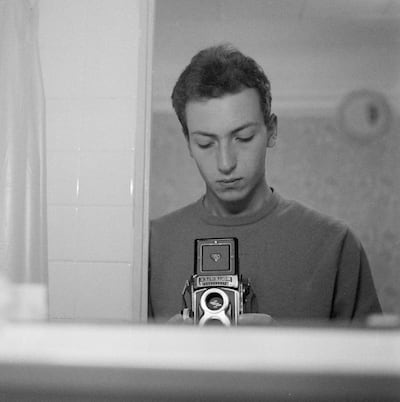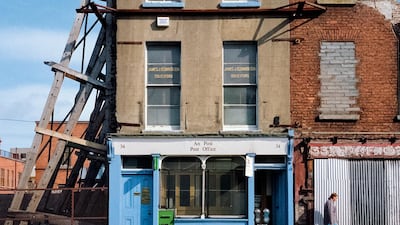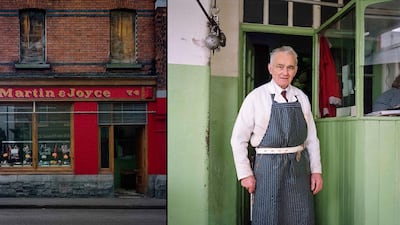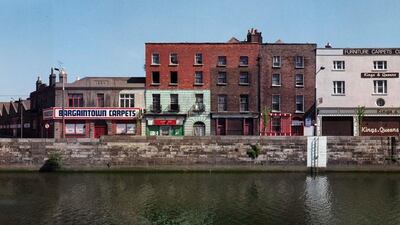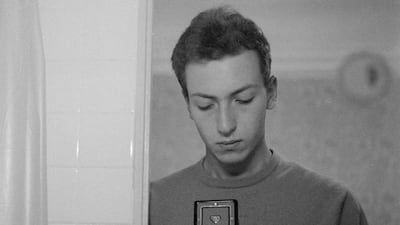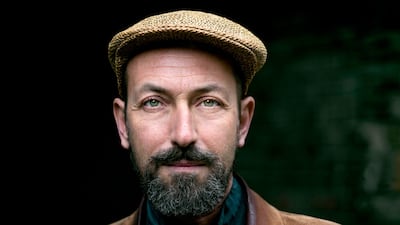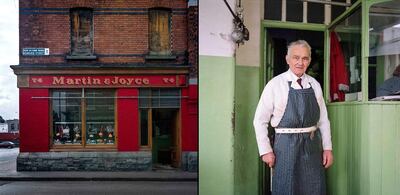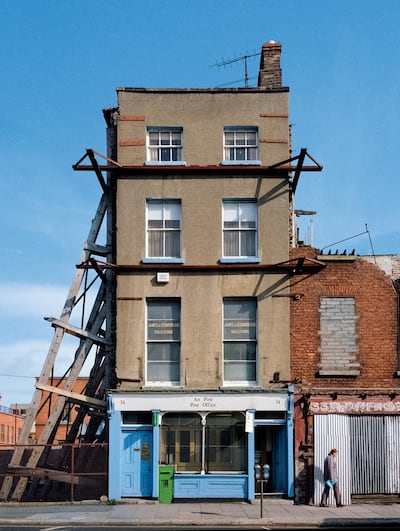Ireland in the 1980s was a place many people wanted to escape. The country was one of the poorest in Europe and huge numbers were emigrating every year. But for David Jazay, it was the other way around. The German photographer arrived in the Irish capital on a Sunday in 1982, as a teenage exchange student.
The inner city of Dublin at this time was home to the faded grandeur of British-era Georgian buildings that were under immediate threat of demolition. The area – where working-class communities had toiled for generations – was about to change for ever.
Few could anticipate Ireland’s boom years ahead – where the dizzying growth mirrored the UAE’s, with cranes filling Dublin’s skies – but Jazay grasped instinctively that this chapter in Dublin’s history needed to be documented before it was erased.
I was fascinated not so much by the dereliction but by the working-class culture and the small shop owners
"I was fascinated not so much by the dereliction, but by the working-class culture and the small shopowners," says Jazay, 54, who is from Munster. "People would chat to you, people had time, and there were children playing in the streets. It was all very different from the Germany I grew up in. I thought it was very beautiful."
The photographs he took show the last of the old antique houses, furniture sellers and corner shops that dotted the quays alongside the beautiful yet dilapidated "Georgian architectural ensembles", as Jazay calls them. The faces of shopowners, children and salesmen stare out from a departed era. And forget grey monochrome shots of poverty and decay: many of the images are immediate and colourful. It is clear Jazay was no misery tourist, but someone genuinely interested in what was happening.
“It boggles my mind that people see bleakness because what I saw was working-class people being able to make a living in the city,” he says. “It was my intention to photograph it in good light because I didn’t want to fall into that narrative of the bleak, depressing post-war thing.”
Jazay used a 1950s-era Rolleiflex T camera to document the era's twilight. It was a twin lens, analogue camera that he found relaxed people when he shot their portraits. "Because you look down and talk to them and make eye contact while you take photos, so it is a very good street camera."
One striking images is of a Sikh trader at an inner city bazaar. "I didn't consider it unusual to see signs of an Asian community, even if Ireland was quite mono-ethnic in those years."
Jazay returned to Ireland every two years, and in 1985 shot a continuous panorama of Dublin’s north quays that line the River Liffey. He would walk 20 metres, take a shot and then do it again. The beauty of the architecture remained despite the poor condition of the buildings and “ghost signs” – previous shop names – were still visible. “It was like a layer cake of history,” he says. “You could actually see the different uses people had put these buildings through in the course of time. All that is gone now, and doesn’t seem to be missed much. But I saw the life in it.”
Jazay snapped about 4,000 images in total and, a few years ago, he scanned some and put them together in digital panoramas. The result is a striking record of Dublin in the latter half of the 1980s. In 1988, Jazay also completed a documentary with Judith Klinger, called Bargaintown, which chronicles some the people he met.
By 1992, the work had finished and Dublin had moved on. Ireland was about to experience a huge economic boom called the Celtic Tiger. The years from 1995 to 2007 were an unprecedented time in Ireland's history, when the country went from being one of the poorest to one of Europe's wealthiest.
Jazay did not visit between 1996 and 2013 as new construction and infrastructure projects transformed the city he chronicled – many buildings were demolished or rebuilt with mock facades – and the places Jazay photographed are now largely redeveloped. The boom was followed in 2008 by one of the sharpest downturns in history.
Jazay named his collection "Dublin Before the Tiger" and it represents a warm and intriguing snapshot of a time and place in the capital's history that has been lost for ever. Jazay is now hoping to stage an exhibition of the photographs in Ireland.
"I've been going back for the past 10 years, and what really shocks me now is the empty brownfield sites. They should have done projects for the community such as rehearsal spaces, parks, sports grounds and things like that," he says.
"I have no wish to judge or indict, but would hope that people saw not just the poverty and dereliction of Dublin before the Tiger, but also the dignity of its people in the face of adversity, their crafts and traditions, and their sense of community."
More information about Dublin Before the Tiger is available at www.davidjazay.com
TECH%20SPECS%3A%20APPLE%20WATCH%20SERIES%208
%3Cp%3E%3Cstrong%3EDisplay%3A%3C%2Fstrong%3E%2041mm%2C%20352%20x%20430%3B%2045mm%2C%20396%20x%20484%3B%20Retina%20LTPO%20OLED%2C%20up%20to%201000%20nits%2C%20always-on%3B%20Ion-X%20glass%3C%2Fp%3E%0A%3Cp%3E%3Cstrong%3EProcessor%3A%3C%2Fstrong%3E%20Apple%20S8%2C%20W3%20wireless%2C%20U1%20ultra-wideband%3C%2Fp%3E%0A%3Cp%3E%3Cstrong%3ECapacity%3A%3C%2Fstrong%3E%2032GB%3C%2Fp%3E%0A%3Cp%3E%3Cstrong%3EMemory%3A%3C%2Fstrong%3E%201GB%3C%2Fp%3E%0A%3Cp%3E%3Cstrong%3EPlatform%3A%3C%2Fstrong%3E%20watchOS%209%3C%2Fp%3E%0A%3Cp%3E%3Cstrong%3EHealth%20metrics%3A%3C%2Fstrong%3E%203rd-gen%20heart%20rate%20sensor%2C%20temperature%20sensing%2C%20ECG%2C%20blood%20oxygen%2C%20workouts%2C%20fall%2Fcrash%20detection%3B%20emergency%20SOS%2C%20international%20emergency%20calling%3C%2Fp%3E%0A%3Cp%3E%3Cstrong%3EConnectivity%3A%3C%2Fstrong%3E%20GPS%2FGPS%20%2B%20cellular%3B%20Wi-Fi%2C%20LTE%2C%20Bluetooth%205.3%2C%20NFC%20(Apple%20Pay)%3C%2Fp%3E%0A%3Cp%3E%3Cstrong%3EDurability%3A%3C%2Fstrong%3E%20IP6X%2C%20water%20resistant%20up%20to%2050m%2C%20dust%20resistant%3C%2Fp%3E%0A%3Cp%3E%3Cstrong%3EBattery%3A%3C%2Fstrong%3E%20308mAh%20Li-ion%2C%20up%20to%2018h%2C%20wireless%20charging%3C%2Fp%3E%0A%3Cp%3E%3Cstrong%3ECards%3A%3C%2Fstrong%3E%20eSIM%3C%2Fp%3E%0A%3Cp%3E%3Cstrong%3EFinishes%3A%3C%2Fstrong%3E%20Aluminium%20%E2%80%93%20midnight%2C%20Product%20Red%2C%20silver%2C%20starlight%3B%20stainless%20steel%20%E2%80%93%20gold%2C%20graphite%2C%20silver%3C%2Fp%3E%0A%3Cp%3E%3Cstrong%3EIn%20the%20box%3A%3C%2Fstrong%3E%20Watch%20Series%208%2C%20magnetic-to-USB-C%20charging%20cable%2C%20band%2Floop%3C%2Fp%3E%0A%3Cp%3E%3Cstrong%3EPrice%3A%3C%2Fstrong%3E%20Starts%20at%20Dh1%2C599%20(41mm)%20%2F%20Dh1%2C999%20(45mm)%3C%2Fp%3E%0A
ABU%20DHABI%20CARD
%3Cp%3E%0D%3Cstrong%3E5pm%3A%3C%2Fstrong%3E%20Al%20Rabi%20Tower%20%E2%80%93%20Maiden%20(PA)%20Dh80%2C000%20(Turf)%201%2C400%0D%3Cbr%3E%3Cstrong%3E5.30pm%3A%3C%2Fstrong%3E%20Wathba%20Stallions%20Cup%20%E2%80%93%20Handicap%20(PA)%20Dh70%2C000%20(T)%201%2C600m%0D%3Cbr%3E%3Cstrong%3E6pm%3A%3C%2Fstrong%3E%20Abu%20Dhabi%20Championship%20%E2%80%93%20Listed%20(PA)%20Dh180%2C000%20(T)%201%2C600m%0D%3Cbr%3E%3Cstrong%3E6.30pm%3A%3C%2Fstrong%3E%20Hili%20Tower%20%E2%80%93%20Handicap%20(PA)%20Dh80%2C000%20(T)%202%2C200m%0D%3Cbr%3E%3Cstrong%3E7pm%3A%20%3C%2Fstrong%3EUAE%20Arabian%20Derby%20%E2%80%93%20Prestige%20(PA)%20Dh150%2C000%20(T)%202%2C200m%0D%3Cbr%3E%3Cstrong%3E7.30pm%3A%3C%2Fstrong%3E%20Abu%20Dhabi%20Championship%20%E2%80%93%20Listed%20(TB)%20Dh380%2C000%20(T)%202%2C200m%3C%2Fp%3E%0A
Five personal finance podcasts from The National
To help you get started, tune into these Pocketful of Dirham episodes
·
Balance is essential to happiness, health and wealth
·
What is a portfolio stress test?
·
What are NFTs and why are auction houses interested?
·
How gamers are getting rich by earning cryptocurrencies
·
Should you buy or rent a home in the UAE?
The%C2%A0specs%20
%3Cp%3E%3Cstrong%3EEngine%3A%20%3C%2Fstrong%3Etwo%20permanent%20magnet%20synchronous%20motors%3Cbr%3E%3Cstrong%3ETransmission%3A%20%3C%2Fstrong%3Etwo-speed%3Cbr%3E%3Cstrong%3EPower%3A%20%3C%2Fstrong%3E625hp%3Cbr%3E%3Cstrong%3ETorque%3A%20%3C%2Fstrong%3E850Nm%3Cbr%3E%3Cstrong%3ERange%3A%20%3C%2Fstrong%3E456km%3Cbr%3E%3Cstrong%3EPrice%3A%20%3C%2Fstrong%3Efrom%20Dh737%2C480%3Cbr%3E%3Cstrong%3EOn%20sale%3A%20%3C%2Fstrong%3Enow%3C%2Fp%3E%0A
'Shakuntala Devi'
Starring: Vidya Balan, Sanya Malhotra
Director: Anu Menon
Rating: Three out of five stars
More from Neighbourhood Watch:
Who was Alfred Nobel?
The Nobel Prize was created by wealthy Swedish chemist and entrepreneur Alfred Nobel.
- In his will he dictated that the bulk of his estate should be used to fund "prizes to those who, during the preceding year, have conferred the greatest benefit to humankind".
- Nobel is best known as the inventor of dynamite, but also wrote poetry and drama and could speak Russian, French, English and German by the age of 17. The five original prize categories reflect the interests closest to his heart.
- Nobel died in 1896 but it took until 1901, following a legal battle over his will, before the first prizes were awarded.
'Peninsula'
Stars: Gang Dong-won, Lee Jung-hyun, Lee Ra
Director: Yeon Sang-ho
Rating: 2/5
MATCH INFO
Chelsea 1 (Hudson-Odoi 90 1')
Manchester City 3 (Gundogan 18', Foden 21', De Bruyne 34')
Man of the match: Ilkay Gundogan (Man City)
Brief scores:
Scotland 371-5, 50 overs (C MacLeod 140 no, K Coetzer 58, G Munsey 55)
England 365 all out, 48.5 overs (J Bairstow 105, A Hales 52; M Watt 3-55)
Result: Scotland won by six runs
The specs: 2018 BMW R nineT Scrambler
Price, base / as tested Dh57,000
Engine 1,170cc air/oil-cooled flat twin four-stroke engine
Transmission Six-speed gearbox
Power 110hp) @ 7,750rpm
Torque 116Nm @ 6,000rpm
Fuel economy, combined 5.3L / 100km
Results
5pm: Maiden (PA) Dh80,000 (Turf) 1,200m, Winner: ES Rubban, Antonio Fresu (jockey), Ibrahim Aseel (trainer)
5.30pm: Handicap (PA) Dh85,000 (T) 1,200m, Winner: Al Mobher, Sczcepan Mazur, Ibrahim Al Hadhrami
6pm: Handicap (PA) Dh80,000 (T) 2,200m, Winner: Jabalini, Tadhg O’Shea, Ibrahim Al Hadhrami
6.30pm: Wathba Stallions Cup (PA) Dh70,000 (T) 2,200m, Winner: AF Abahe, Tadgh O’Shea, Ernst Oertel
7pm: Handicap (PA) Dh85,000 (T) 1,600m, Winner: AF Makerah, Tadhg O’Shea, Ernst Oertel
7.30pm: Maiden (TB) Dh80,000 (T) 1,600m, Winner: Law Of Peace, Tadhg O’Shea, Satish Seemar
Who's who in Yemen conflict
Houthis: Iran-backed rebels who occupy Sanaa and run unrecognised government
Yemeni government: Exiled government in Aden led by eight-member Presidential Leadership Council
Southern Transitional Council: Faction in Yemeni government that seeks autonomy for the south
Habrish 'rebels': Tribal-backed forces feuding with STC over control of oil in government territory
Profile Idealz
Company: Idealz
Founded: January 2018
Based: Dubai
Sector: E-commerce
Size: (employees): 22
Investors: Co-founders and Venture Partners (9 per cent)
Heather, the Totality
Matthew Weiner,
Canongate
Why it pays to compare
A comparison of sending Dh20,000 from the UAE using two different routes at the same time - the first direct from a UAE bank to a bank in Germany, and the second from the same UAE bank via an online platform to Germany - found key differences in cost and speed. The transfers were both initiated on January 30.
Route 1: bank transfer
The UAE bank charged Dh152.25 for the Dh20,000 transfer. On top of that, their exchange rate margin added a difference of around Dh415, compared with the mid-market rate.
Total cost: Dh567.25 - around 2.9 per cent of the total amount
Total received: €4,670.30
Route 2: online platform
The UAE bank’s charge for sending Dh20,000 to a UK dirham-denominated account was Dh2.10. The exchange rate margin cost was Dh60, plus a Dh12 fee.
Total cost: Dh74.10, around 0.4 per cent of the transaction
Total received: €4,756
The UAE bank transfer was far quicker – around two to three working days, while the online platform took around four to five days, but was considerably cheaper. In the online platform transfer, the funds were also exposed to currency risk during the period it took for them to arrive.
The specs
Engine: Turbocharged four-cylinder 2.7-litre
Power: 325hp
Torque: 500Nm
Transmission: 10-speed automatic
Price: From Dh189,700
On sale: now
Timeline
2012-2015
The company offers payments/bribes to win key contracts in the Middle East
May 2017
The UK SFO officially opens investigation into Petrofac’s use of agents, corruption, and potential bribery to secure contracts
September 2021
Petrofac pleads guilty to seven counts of failing to prevent bribery under the UK Bribery Act
October 2021
Court fines Petrofac £77 million for bribery. Former executive receives a two-year suspended sentence
December 2024
Petrofac enters into comprehensive restructuring to strengthen the financial position of the group
May 2025
The High Court of England and Wales approves the company’s restructuring plan
July 2025
The Court of Appeal issues a judgment challenging parts of the restructuring plan
August 2025
Petrofac issues a business update to execute the restructuring and confirms it will appeal the Court of Appeal decision
October 2025
Petrofac loses a major TenneT offshore wind contract worth €13 billion. Holding company files for administration in the UK. Petrofac delisted from the London Stock Exchange
November 2025
180 Petrofac employees laid off in the UAE
Company%C2%A0profile
%3Cp%3E%3Cstrong%3ECompany%20name%3A%20%3C%2Fstrong%3EHayvn%3Cbr%3E%3Cstrong%3EStarted%3A%20%3C%2Fstrong%3E2018%3Cbr%3E%3Cstrong%3EFounders%3A%20%3C%2Fstrong%3EChristopher%20Flinos%2C%20Ahmed%20Ismail%3Cbr%3E%3Cstrong%3EBased%3A%20%3C%2Fstrong%3EAbu%20Dhabi%2C%20UAE%3Cbr%3E%3Cstrong%3ESector%3A%20%3C%2Fstrong%3Efinancial%3Cbr%3E%3Cstrong%3EInitial%20investment%3A%20%3C%2Fstrong%3Eundisclosed%3Cbr%3E%3Cstrong%3ESize%3A%3C%2Fstrong%3E%2044%20employees%3Cbr%3E%3Cstrong%3EInvestment%20stage%3A%20%3C%2Fstrong%3Eseries%20B%20in%20the%20second%20half%20of%202023%3Cbr%3E%3Cstrong%3EInvestors%3A%20%3C%2Fstrong%3EHilbert%20Capital%2C%20Red%20Acre%20Ventures%3C%2Fp%3E%0A
Results
STAGE
1 . Filippo Ganna (Ineos) - 0:13:56
2. Stefan Bissegger (Education-Nippo) - 0:00:14
3. Mikkel Bjerg (UAE Team Emirates) - 0:00:21
4. Tadej Pogacar (UAE Team Emirates) - 0:00:24
5. Luis Leon Sanchez (Astana) - 0:00:30
GENERAL CLASSIFICATION
1. Tadej Pogacar (UAE Team Emirates) - 4:00:05
2. Joao Almeida (QuickStep) - 0:00:05
3. Mattia Cattaneo (QuickStep) - 0:00:18
4. Chris Harper (Jumbo-Visma) - 0:00:33
5. Adam Yates (Ineos) - 0:00:39
The Bio
Favourite holiday destination: Either Kazakhstan or Montenegro. I’ve been involved in events in both countries and they are just stunning.
Favourite book: I am a huge of Robin Cook’s medical thrillers, which I suppose is quite apt right now. My mother introduced me to them back home in New Zealand.
Favourite film or television programme: Forrest Gump is my favourite film, that’s never been up for debate. I love watching repeats of Mash as well.
Inspiration: My late father moulded me into the man I am today. I would also say disappointment and sadness are great motivators. There are times when events have brought me to my knees but it has also made me determined not to let them get the better of me.
UAE FIXTURES
October 18 – 7.30pm, UAE v Oman, Zayed Cricket Stadium, Abu Dhabi
October 19 – 7.30pm, UAE v Ireland, Zayed Cricket Stadium, Abu Dhabi
October 21 – 2.10pm, UAE v Hong Kong, Zayed Cricket Stadium, Abu Dhabi
October 22 – 2.10pm, UAE v Jersey, Zayed Cricket Stadium, Abu Dhabi
October 24 – 10am, UAE v Nigeria, Abu Dhabi Cricket Oval 1
October 27 – 7.30pm, UAE v Canada, Zayed Cricket Stadium, Abu Dhabi
October 29 – 2.10pm, Playoff 1 – A2 v B3; 7.30pm, Playoff 2 – A3 v B2, at Dubai International Stadium.
October 30 – 2.10pm, Playoff 3 – A4 v Loser of Play-off 1; 7.30pm, Playoff 4 – B4 v Loser of Play-off 2 at Dubai International Stadium
November 1 – 2.10pm, Semifinal 1 – B1 v Winner of Play-off 1; 7.30pm, Semifinal 2 – A1 v Winner of Play-off 2 at Dubai International Stadium
November 2 – 2.10pm, Third place Playoff – B1 v Winner of Play-off 1; 7.30pm, Final, at Dubai International Stadium
FINAL SCORES
Fujairah 130 for 8 in 20 overs
(Sandy Sandeep 29, Hamdan Tahir 26 no, Umair Ali 2-15)
Sharjah 131 for 8 in 19.3 overs
(Kashif Daud 51, Umair Ali 20, Rohan Mustafa 2-17, Sabir Rao 2-26)
Cherry
Directed by: Joe and Anthony Russo
Starring: Tom Holland, Ciara Bravo
1/5
Our legal advisor
Ahmad El Sayed is Senior Associate at Charles Russell Speechlys, a law firm headquartered in London with offices in the UK, Europe, the Middle East and Hong Kong.
Experience: Commercial litigator who has assisted clients with overseas judgments before UAE courts. His specialties are cases related to banking, real estate, shareholder disputes, company liquidations and criminal matters as well as employment related litigation.
Education: Sagesse University, Beirut, Lebanon, in 2005.
Tailors and retailers miss out on back-to-school rush
Tailors and retailers across the city said it was an ominous start to what is usually a busy season for sales.
With many parents opting to continue home learning for their children, the usual rush to buy school uniforms was muted this year.
“So far we have taken about 70 to 80 orders for items like shirts and trousers,” said Vikram Attrai, manager at Stallion Bespoke Tailors in Dubai.
“Last year in the same period we had about 200 orders and lots of demand.
“We custom fit uniform pieces and use materials such as cotton, wool and cashmere.
“Depending on size, a white shirt with logo is priced at about Dh100 to Dh150 and shorts, trousers, skirts and dresses cost between Dh150 to Dh250 a piece.”
A spokesman for Threads, a uniform shop based in Times Square Centre Dubai, said customer footfall had slowed down dramatically over the past few months.
“Now parents have the option to keep children doing online learning they don’t need uniforms so it has quietened down.”
UAE currency: the story behind the money in your pockets
If you go
The flights
Emirates and Etihad fly direct to Nairobi, with fares starting from Dh1,695. The resort can be reached from Nairobi via a 35-minute flight from Wilson Airport or Jomo Kenyatta International Airport, or by road, which takes at least three hours.
The rooms
Rooms at Fairmont Mount Kenya range from Dh1,870 per night for a deluxe room to Dh11,000 per night for the William Holden Cottage.
The President's Cake
Director: Hasan Hadi
Starring: Baneen Ahmad Nayyef, Waheed Thabet Khreibat, Sajad Mohamad Qasem
Rating: 4/5
WOMAN AND CHILD
Director: Saeed Roustaee
Starring: Parinaz Izadyar, Payman Maadi
Rating: 4/5
CONCRETE COWBOY
Directed by: Ricky Staub
Starring: Idris Elba, Caleb McLaughlin, Jharrel Jerome
3.5/5 stars
Emergency phone numbers in the UAE
Estijaba – 8001717 – number to call to request coronavirus testing
Ministry of Health and Prevention – 80011111
Dubai Health Authority – 800342 – The number to book a free video or voice consultation with a doctor or connect to a local health centre
Emirates airline – 600555555
Etihad Airways – 600555666
Ambulance – 998
Knowledge and Human Development Authority – 8005432 ext. 4 for Covid-19 queries
The specs
Engine: 6.2-litre V8
Power: 502hp at 7,600rpm
Torque: 637Nm at 5,150rpm
Transmission: 8-speed dual-clutch auto
Price: from Dh317,671
On sale: now
What are NFTs?
Are non-fungible tokens a currency, asset, or a licensing instrument? Arnab Das, global market strategist EMEA at Invesco, says they are mix of all of three.
You can buy, hold and use NFTs just like US dollars and Bitcoins. “They can appreciate in value and even produce cash flows.”
However, while money is fungible, NFTs are not. “One Bitcoin, dollar, euro or dirham is largely indistinguishable from the next. Nothing ties a dollar bill to a particular owner, for example. Nor does it tie you to to any goods, services or assets you bought with that currency. In contrast, NFTs confer specific ownership,” Mr Das says.
This makes NFTs closer to a piece of intellectual property such as a work of art or licence, as you can claim royalties or profit by exchanging it at a higher value later, Mr Das says. “They could provide a sustainable income stream.”
This income will depend on future demand and use, which makes NFTs difficult to value. “However, there is a credible use case for many forms of intellectual property, notably art, songs, videos,” Mr Das says.
Panipat
Director Ashutosh Gowariker
Produced Ashutosh Gowariker, Rohit Shelatkar, Reliance Entertainment
Cast Arjun Kapoor, Sanjay Dutt, Kriti Sanon, Mohnish Behl, Padmini Kolhapure, Zeenat Aman
Rating 3 /5 stars
Specs
Engine: Dual-motor all-wheel-drive electric
Range: Up to 610km
Power: 905hp
Torque: 985Nm
Price: From Dh439,000
Available: Now
Zayed Sustainability Prize
Living in...
This article is part of a guide on where to live in the UAE. Our reporters will profile some of the country’s most desirable districts, provide an estimate of rental prices and introduce you to some of the residents who call each area home.
pakistan Test squad
Azhar Ali (capt), Shan Masood, Abid Ali, Imam-ul-Haq, Asad Shafiq, Babar Azam, Fawad Alam, Haris Sohail, Imran Khan, Kashif Bhatti, Mohammad Rizwan (wk), Naseem Shah, Shaheen Shah Afridi, Mohammad Abbas, Yasir Shah, Usman Shinwari
UAE%20medallists%20at%20Asian%20Games%202023
%3Cp%3E%3Cstrong%3EGold%3C%2Fstrong%3E%0D%3Cbr%3EMagomedomar%20Magomedomarov%20%E2%80%93%20Judo%20%E2%80%93%20Men%E2%80%99s%20%2B100kg%0D%3Cbr%3EKhaled%20Al%20Shehi%20%E2%80%93%20Jiu-jitsu%20%E2%80%93%20Men%E2%80%99s%20-62kg%0D%3Cbr%3EFaisal%20Al%20Ketbi%20%E2%80%93%20Jiu-jitsu%20%E2%80%93%20Men%E2%80%99s%20-85kg%0D%3Cbr%3EAsma%20Al%20Hosani%20%E2%80%93%20Jiu-jitsu%20%E2%80%93%20Women%E2%80%99s%20-52kg%0D%3Cbr%3EShamma%20Al%20Kalbani%20%E2%80%93%20Jiu-jitsu%20%E2%80%93%20Women%E2%80%99s%20-63kg%0D%3Cbr%3E%3Cstrong%3ESilver%3C%2Fstrong%3E%0D%3Cbr%3EOmar%20Al%20Marzooqi%20%E2%80%93%20Equestrian%20%E2%80%93%20Individual%20showjumping%0D%3Cbr%3EBishrelt%20Khorloodoi%20%E2%80%93%20Judo%20%E2%80%93%20Women%E2%80%99s%20-52kg%0D%3Cbr%3EKhalid%20Al%20Blooshi%20%E2%80%93%20Jiu-jitsu%20%E2%80%93%20Men%E2%80%99s%20-62kg%0D%3Cbr%3EMohamed%20Al%20Suwaidi%20%E2%80%93%20Jiu-jitsu%20%E2%80%93%20Men%E2%80%99s%20-69kg%0D%3Cbr%3EBalqees%20Abdulla%20%E2%80%93%20Jiu-jitsu%20%E2%80%93%20Women%E2%80%99s%20-48kg%0D%3Cbr%3E%3Cstrong%3EBronze%3C%2Fstrong%3E%0D%3Cbr%3EHawraa%20Alajmi%20%E2%80%93%20Karate%20%E2%80%93%20Women%E2%80%99s%20kumite%20-50kg%0D%3Cbr%3EAhmed%20Al%20Mansoori%20%E2%80%93%20Cycling%20%E2%80%93%20Men%E2%80%99s%20omnium%0D%3Cbr%3EAbdullah%20Al%20Marri%20%E2%80%93%20Equestrian%20%E2%80%93%20Individual%20showjumping%0D%3Cbr%3ETeam%20UAE%20%E2%80%93%20Equestrian%20%E2%80%93%20Team%20showjumping%0D%3Cbr%3EDzhafar%20Kostoev%20%E2%80%93%20Judo%20%E2%80%93%20Men%E2%80%99s%20-100kg%0D%3Cbr%3ENarmandakh%20Bayanmunkh%20%E2%80%93%20Judo%20%E2%80%93%20Men%E2%80%99s%20-66kg%0D%3Cbr%3EGrigorian%20Aram%20%E2%80%93%20Judo%20%E2%80%93%20Men%E2%80%99s%20-90kg%0D%3Cbr%3EMahdi%20Al%20Awlaqi%20%E2%80%93%20Jiu-jitsu%20%E2%80%93%20Men%E2%80%99s%20-77kg%0D%3Cbr%3ESaeed%20Al%20Kubaisi%20%E2%80%93%20Jiu-jitsu%20%E2%80%93%20Men%E2%80%99s%20-85kg%0D%3Cbr%3EShamsa%20Al%20Ameri%20%E2%80%93%20Jiu-jitsu%20%E2%80%93%20Women%E2%80%99s%20-57kg%0D%3C%2Fp%3E%0A
How the bonus system works
The two riders are among several riders in the UAE to receive the top payment of £10,000 under the Thank You Fund of £16 million (Dh80m), which was announced in conjunction with Deliveroo's £8 billion (Dh40bn) stock market listing earlier this year.
The £10,000 (Dh50,000) payment is made to those riders who have completed the highest number of orders in each market.
There are also riders who will receive payments of £1,000 (Dh5,000) and £500 (Dh2,500).
All riders who have worked with Deliveroo for at least one year and completed 2,000 orders will receive £200 (Dh1,000), the company said when it announced the scheme.
Groom and Two Brides
Director: Elie Semaan
Starring: Abdullah Boushehri, Laila Abdallah, Lulwa Almulla
Rating: 3/5
Pearls on a Branch: Oral Tales
Najlaa Khoury, Archipelago Books
Profile box
Founders: Michele Ferrario, Nino Ulsamer and Freddy Lim
Started: established in 2016 and launched in July 2017
Based: Singapore, with offices in the UAE, Malaysia, Hong Kong, Thailand
Sector: FinTech, wealth management
Initial investment: $500,000 in seed round 1 in 2016; $2.2m in seed round 2 in 2017; $5m in series A round in 2018; $12m in series B round in 2019; $16m in series C round in 2020 and $25m in series D round in 2021
Current staff: more than 160 employees
Stage: series D
Investors: EightRoads Ventures, Square Peg Capital, Sequoia Capital India
The 12
England
Arsenal, Chelsea, Liverpool, Manchester City, Manchester United, Tottenham Hotspur
Italy
AC Milan, Inter Milan, Juventus
Spain
Atletico Madrid, Barcelona, Real Madrid
Thor%3A%20Love%20and%20Thunder%20
%3Cp%3E%3Cstrong%3EDirector%3A%3C%2Fstrong%3E%20Taika%20Waititi%C2%A0%3C%2Fp%3E%0A%3Cp%3E%3Cstrong%3EStars%3A%3C%2Fstrong%3E%20Chris%20Hemsworth%2C%20Natalie%20Portman%2C%20Christian%20Bale%2C%20Russell%20Crowe%2C%20Tessa%20Thompson%2C%20Taika%20Waititi%3C%2Fp%3E%0A%3Cp%3E%3Cstrong%3ERating%3A%3C%2Fstrong%3E%204%2F5%3C%2Fp%3E%0A
Dust and sand storms compared
Sand storm
- Particle size: Larger, heavier sand grains
- Visibility: Often dramatic with thick "walls" of sand
- Duration: Short-lived, typically localised
- Travel distance: Limited
- Source: Open desert areas with strong winds
Dust storm
- Particle size: Much finer, lightweight particles
- Visibility: Hazy skies but less intense
- Duration: Can linger for days
- Travel distance: Long-range, up to thousands of kilometres
- Source: Can be carried from distant regions
Profile
Company: Justmop.com
Date started: December 2015
Founders: Kerem Kuyucu and Cagatay Ozcan
Sector: Technology and home services
Based: Jumeirah Lake Towers, Dubai
Size: 55 employees and 100,000 cleaning requests a month
Funding: The company’s investors include Collective Spark, Faith Capital Holding, Oak Capital, VentureFriends, and 500 Startups.
Our legal consultant
Name: Dr Hassan Mohsen Elhais
Position: legal consultant with Al Rowaad Advocates and Legal Consultants.
MEYDAN CARD
6.30pm Al Maktoum Challenge Round-1 Group One (PA) US$65,000 (Dirt) 1,600m
7.05pm Handicap (TB) $175,000 (Turf) 1,200m
7.40pm UAE 2000 Guineas Trial Conditions (TB) $100,000 (D) 1,600m
8.15pm Singspiel Stakes Group Two (TB) $250,000 (T) 1,800m
8.50pm Handicap (TB) $135,000 (T) 1,600m
9.25pm Al Maktoum Challenge Round-1 Group Two (TB) $350,000 (D) 1,600m
10pm Dubai Trophy Conditions (TB) $100,000 (T) 1,200m
10.35pm Handicap (TB) $135,000 (T) 1,600m
The National selections:
6.30pm AF Alwajel
7.05pm Ekhtiyaar
7.40pm First View
8.15pm Benbatl
8.50pm Zakouski
9.25pm: Kimbear
10pm: Chasing Dreams
10.35pm: Good Fortune
Where can I submit a sample?
Volunteers can now submit DNA samples at a number of centres across Abu Dhabi. The programme is open to all ages.
Collection centres in Abu Dhabi include:
- Abu Dhabi National Exhibition Centre (ADNEC)
- Biogenix Labs in Masdar City
- Al Towayya in Al Ain
- NMC Royal Hospital in Khalifa City
- Bareen International Hospital
- NMC Specialty Hospital, Al Ain
- NMC Royal Medical Centre - Abu Dhabi
- NMC Royal Women’s Hospital.
'Avengers: Infinity War'
Dir: The Russo Brothers
Starring: Chris Evans, Chris Pratt, Tom Holland, Robert Downey Junior, Scarlett Johansson, Elizabeth Olsen
Four stars
Tonight's Chat on The National
Tonight's Chat is a series of online conversations on The National. The series features a diverse range of celebrities, politicians and business leaders from around the Arab world.
Tonight’s Chat host Ricardo Karam is a renowned author and broadcaster who has previously interviewed Bill Gates, Carlos Ghosn, Andre Agassi and the late Zaha Hadid, among others.
Intellectually curious and thought-provoking, Tonight’s Chat moves the conversation forward.
Facebook | Our website | Instagram
UAE currency: the story behind the money in your pockets
The specs
Engine: 1.4-litre 4-cylinder turbo
Power: 180hp at 5,500rpm
Torque: 250Nm at 3,00rpm
Transmission: 5-speed sequential auto
Price: From Dh139,995
On sale: now
MORE ON TURKEY'S SYRIA OFFENCE
The%20specs
%3Cp%3E%3Cstrong%3EEngine%3A%20%3C%2Fstrong%3E2.0-litre%20turbocharged%204-cyl%0D%3Cbr%3E%3Cstrong%3ETransmission%3A%20%3C%2Fstrong%3E8-speed%20auto%0D%3Cbr%3E%3Cstrong%3EPower%3A%20%3C%2Fstrong%3E300bhp%20(GT)%20330bhp%20(Modena)%0D%3Cbr%3E%3Cstrong%3ETorque%3A%20%3C%2Fstrong%3E450Nm%0D%3Cbr%3E%3Cstrong%3EPrice%3A%20%3C%2Fstrong%3EDh299%2C000%20(GT)%2C%20Dh369%2C000%20(Modena)%3Cbr%3E%3Cstrong%3EOn%20sale%3A%20%3C%2Fstrong%3Enow%3C%2Fp%3E%0A
Living in...
This article is part of a guide on where to live in the UAE. Our reporters will profile some of the country’s most desirable districts, provide an estimate of rental prices and introduce you to some of the residents who call each area home.

